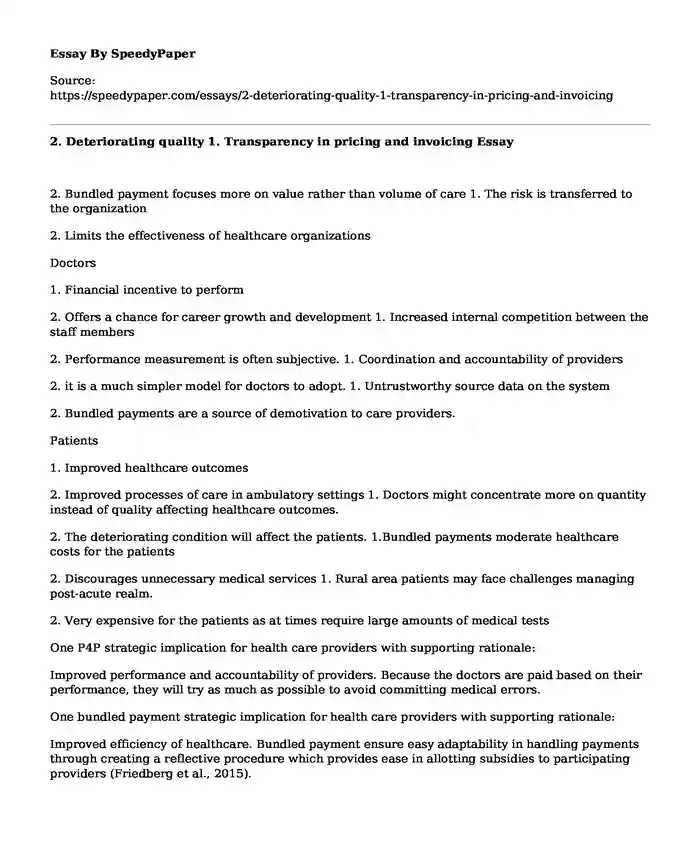2. Bundled payment focuses more on value rather than volume of care 1. The risk is transferred to the organization
2. Limits the effectiveness of healthcare organizations
Doctors
1. Financial incentive to perform
2. Offers a chance for career growth and development 1. Increased internal competition between the staff members
2. Performance measurement is often subjective. 1. Coordination and accountability of providers
2. it is a much simpler model for doctors to adopt. 1. Untrustworthy source data on the system
2. Bundled payments are a source of demotivation to care providers.
Patients
1. Improved healthcare outcomes
2. Improved processes of care in ambulatory settings 1. Doctors might concentrate more on quantity instead of quality affecting healthcare outcomes.
2. The deteriorating condition will affect the patients. 1.Bundled payments moderate healthcare costs for the patients
2. Discourages unnecessary medical services 1. Rural area patients may face challenges managing post-acute realm.
2. Very expensive for the patients as at times require large amounts of medical tests
One P4P strategic implication for health care providers with supporting rationale:
Improved performance and accountability of providers. Because the doctors are paid based on their performance, they will try as much as possible to avoid committing medical errors.
One bundled payment strategic implication for health care providers with supporting rationale:
Improved efficiency of healthcare. Bundled payment ensure easy adaptability in handling payments through creating a reflective procedure which provides ease in allotting subsidies to participating providers (Friedberg et al., 2015).
In 100 words or less, describe two differences or two similarities comparing/contrasting how value-based purchasing differs or is similar to bundled payments and P4P. Your choice as to whether you address similarities or differences (No need to discuss both similarities and differences).
Differences between value-based care and pay for performance
In value-based care, the clinicians take into consideration their quality of healthcare provided and charge higher fees to their high-quality services offered. The doctors consider the best practices when treating patients as they are paid based on their efficiency and quality of services provided (Tsevat, & Moriates, 2018). On the other hand, P4P does not put much emphasis on the quality of medical care provided, but the volume achieved. Doctors are paid according to the number of patients they treat. Secondly, value-based care models promote a better and holistic approach to medical care through coordination and efficient communication among physicians. However, P4P is more volume based than quality based.
References (APA format):
1. Friedberg, M. W., Chen, P. G., White, C., Jung, O., Raaen, L., Hirshman, S., & Tutty, M. (2015). Effects of health care payment models on physician practice in the United States. Rand health quarterly, 5(1). Retrieved from https://www.ncbi.nlm.nih.gov/pmc/articles/PMC5158241/
2. Tsevat, J., & Moriates, C. (2018). Value-Based Health Care Meets Cost-Effectiveness Analysis. Annals of internal medicine.
Cite this page
2. Deteriorating quality 1. Transparency in pricing and invoicing. (2022, Dec 09). Retrieved from https://speedypaper.com/essays/2-deteriorating-quality-1-transparency-in-pricing-and-invoicing
Request Removal
If you are the original author of this essay and no longer wish to have it published on the SpeedyPaper website, please click below to request its removal:
- Impacts of Immigration and Bill Clinton's Scandals in America
- An Essay Sample on Clarifying Content Priorities
- Essay Sample on the Inquisition's First Targets
- Essay Sample on Bankruptcy Law: A Lifeline to Businesses in Distress
- Paper Example. Supply Chain and Logistics Management
- Free Essay Sample. Brazilian Mining Case
- Essay Sample on Literature Review: Leading Multicultural Teams
Popular categories





